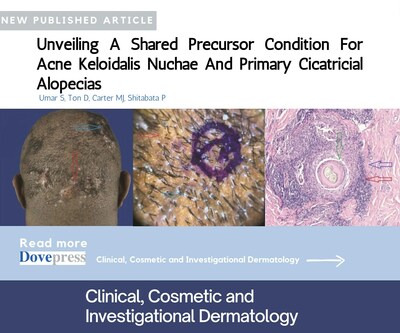LOS ANGELES, Sept. 5, 2023 /PRNewswire-HISPANIC PR WIRE/ — Researchers at Dr. U Hair and Skin Clinic in Los Angeles uncover a crucial link between two medically challenging conditions – Acne Keloidalis Nuchae and Primary Cicatricial Alopecias often called scarring alopecias. Published in the Clinical Cosmetic and Investigational Dermatology journal under “Unveiling a Common Precursor Condition for Acne Keloidalis Nuchae and Primary Cicatricial Alopecias,” the findings have significant implications for diagnostics and treatments.

Acne Keloidalis Nuchae (AKN) is one of a group of scalp conditions called scarring alopecias, known for chronic inflammation causing scarring hair loss with pain, discharge, itching, and social debilitation. AKN often results in disfiguring keloid-like lesions. The research investigated hidden links and shared root conditions.
Traditionally, AKN and scarring alopecias were studied in isolation. This research reveals a link called “Perifollicular Infundibulo-Isthmic Lymphocytic Infiltrates Fibrosis” (PIILIF), identified in the normal-appearing scalp (NAS) zones of all AKN patients. PIILIF could shed light on early AKN and scarring alopecia stages. Dr. Sanusi Umar, the study’s lead researcher, also head of the scalp and hair disorder section at Harbor-UCLA’s dermatology division, underscores that this discovery suggests the potential for more precise therapies targeting root causes and refining diagnostic strategies.
Dr. Umar explained, “Our findings, along with other studies, suggest that PIILIF potentially links all common scarring alopecias, such as AKN, folliculitis decalvas (FD), lichen planopilaris (LPP), frontal fibrosing alopecia, and central centrifugal cicatricial alopecia. This highlights their interconnections, offering new insights into their origins and enabling a more holistic diagnostic and therapeutic strategy. Moreover, this might streamline the intricate classification of scarring alopecias by reducing redundancies in closely related conditions. For instance, our research questions the necessity of the entity currently designated LPP-FD phenotype.”
Surprisingly, the study found AKN to be more prevalent than previously realized in European-descended White males (10% of patients), often unnoticed or misdiagnosed as nape irritation or dandruff. This finding challenges AKN’s perception as solely affecting people of color.
The study has significant implications, potentially reshaping our understanding of AKN, scarring alopecia, and treatments. Further research is needed to uncover PIILIF’s mechanisms, triggers, and role in hair loss. Nonetheless, this work paves the way for improved diagnosis, treatment, and patient well-being.
For media inquiries, please contact:
Sara Harutyunyan
Dr. U Hair and Skin Clinic
[email protected]

Photo – https://mma.prnewswire.com/media/2200523/Unveiling_PIILIF_Graphic.jpg
Logo – https://mma.prnewswire.com/media/2170144/Dr_U_Hair_and_Skin_Clinic_Logo.jpg
SOURCE Dr. U Hair and Skin Clinic







